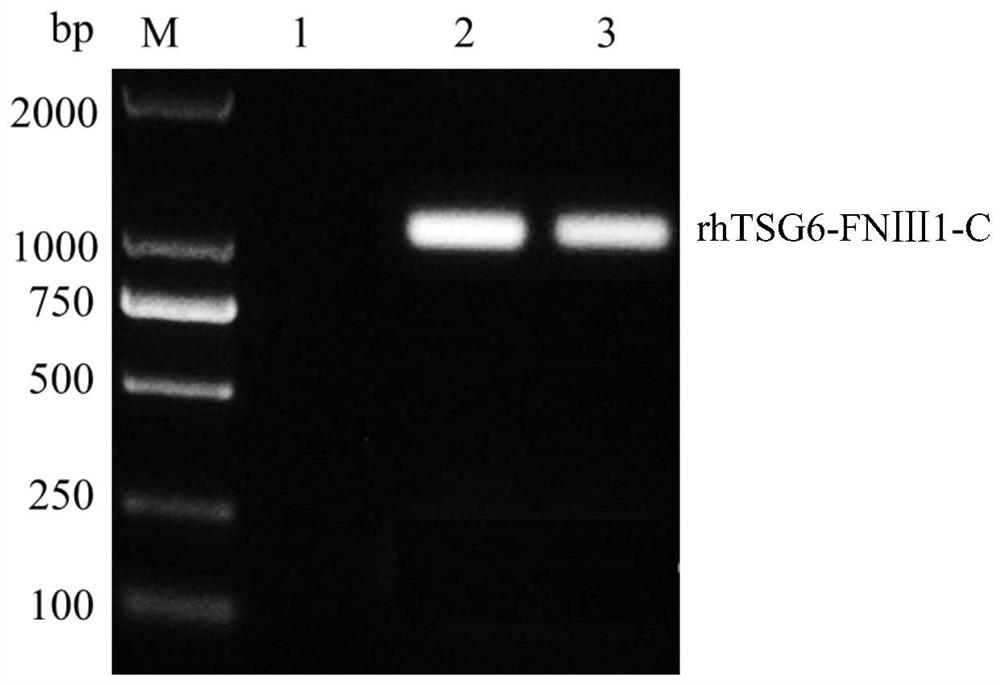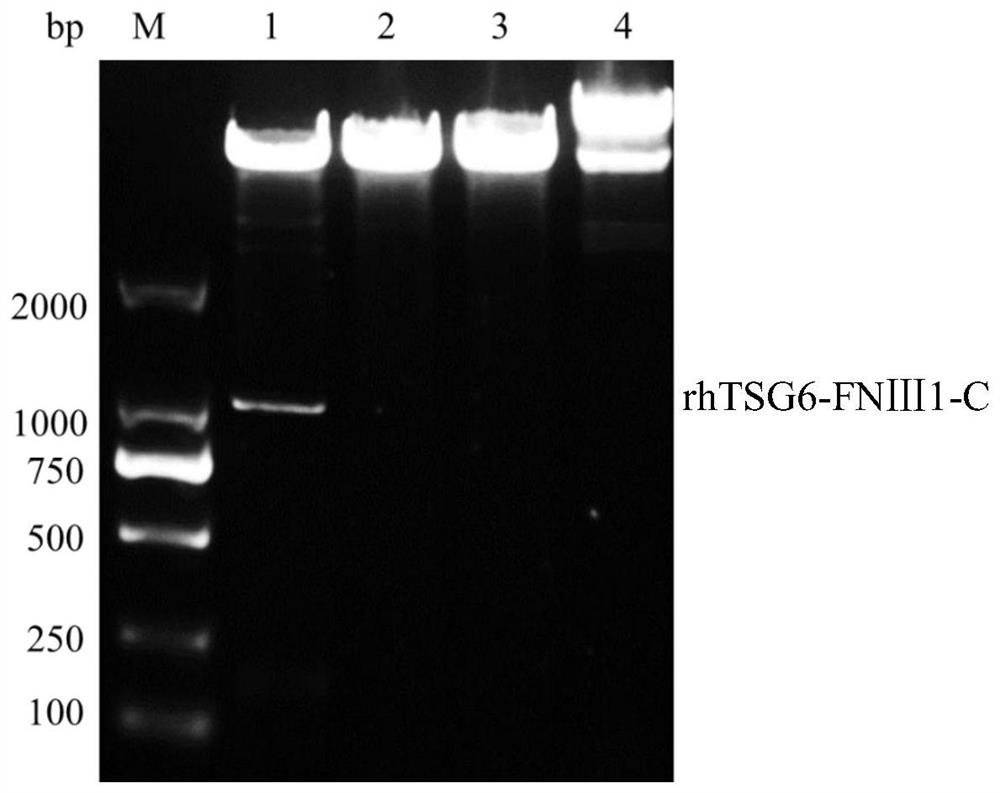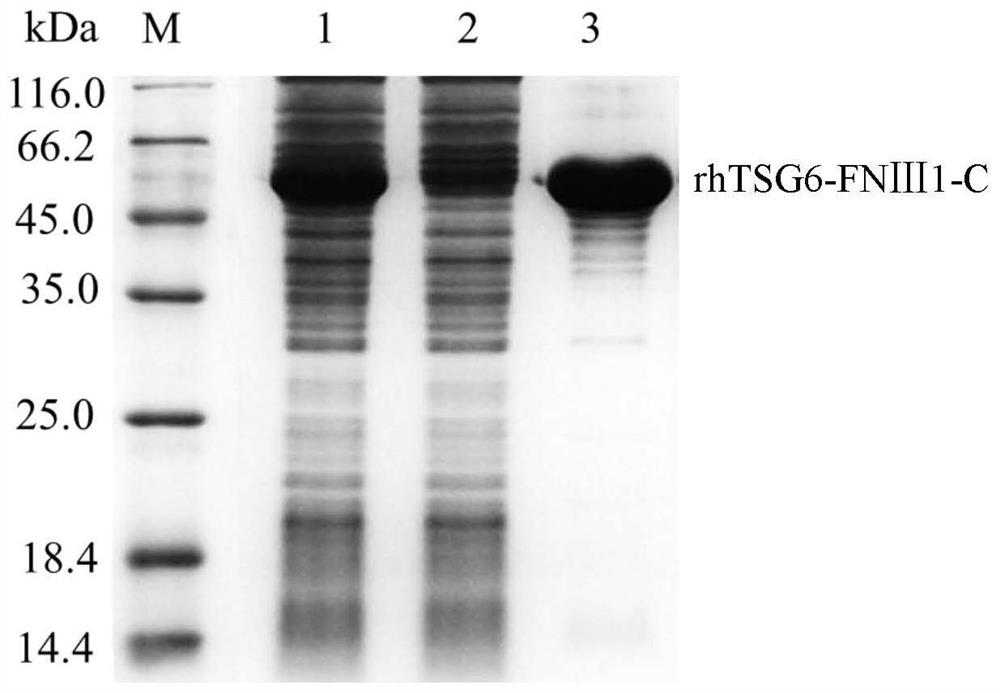A kind of rhtsg6-fnⅢ1-c fusion protein and its use in skin care composition and its preparation method
A rhtsg6-fniii1-c, fusion protein technology, applied in the preparation methods of peptides, preparations for skin care, methods based on microorganisms, etc. The problem is to achieve the effect of simple preparation method, less skin allergy and low production cost
- Summary
- Abstract
- Description
- Claims
- Application Information
AI Technical Summary
Problems solved by technology
Method used
Image
Examples
Embodiment 1
[0071] Preparation of recombinant expression vector for producing rhTSG6-FNⅢ1-C fusion protein and transformation of recombinant microorganism
[0072] The optimized gene encoding the rhTSG6-FNⅢ1-C fusion protein, the recombinant expression vector and the transformed recombinant microorganism were produced by the following methods.
[0073] Using the gene encoding rhFNⅢ1-C protein and rhTSG-6 used as a chaperone protein as a template, an optimized rhTSG6-FNⅢ1-C fusion protein encoding 349 amino acids that can be expressed in host microorganisms was produced and synthesized The fragment of the gene (SEQ ID NO: 1), which was amplified by the primers shown in Table 1 through overlap extension PCR technology, was treated with BamHI and HindIII double enzymes, and pET-32a vector with the same double enzyme digestion connect.
[0074] Table 1 PCR amplification primers
[0075]
[0076] Thus, the pET-32a-rhTSG-6-FNIII1-C recombinant plasmid was produced. For the identification ...
Embodiment 2
[0080] Expression Induction, Isolation and Purification of rhTSG6-FNⅢ1-C Fusion Protein
[0081] Fermentation tank fermentation: Prepare 2 bottles of LB medium, inoculate after high-pressure steam sterilization, and culture overnight at 37°C in shake flasks; the next day, prepare 20L system fermenter medium and dissolve it; install the pH electrode and dissolved oxygen electrode, and add the medium , when the culture medium is heated to 37°C, add ammonia water to adjust the pH to 7.0, and 1mL of antifoaming agent to reduce the influence of foam during fermentation on the experiment; adjust the "temperature T" option to sterilization mode (121°C, 20min), while irradiating the room with ultraviolet rays to establish a relatively closed and sterile environment; when the sterilization in the tank is completed and the temperature drops to 37°C, the alcohol spray can is sprayed on the top of the tank to burn, and the feed inlet is opened in the fire ring. Pour the seed liquid into t...
Embodiment 3
[0089] Identification of rhTSG6-FNⅢ1-C fusion protein by Western blot
[0090] The rhTSG6-FNⅢ1-C fusion protein purification product prepared in Example 2 was separated by polyacrylamide gel electrophoresis (SDS-PAGE), and transferred to a membrane by wet transfer method. After the transfer, the PVDF membrane was immersed in the blocking solution and placed at 37°C for 60 minutes to block. The blocked PVDF membrane was immersed in the primary antibody (Abcam rabbit anti-human TSG-6 polyclonal antibody, diluted 1:2000) diluted in blocking solution, and incubated overnight at 4°C. Rinse the PVDF membrane 3 times with TBST buffer on a shaker, 5 minutes each time. The washed PVDF was immersed in the secondary antibody (horseradish peroxidase-labeled goat anti-rabbit IgG, diluted 1:50000) diluted in blocking solution, and incubated at 37°C for 1 hour. Then soak the PVDF membrane with TBST buffer 3 times, 5 minutes each time. Freshly prepared ECL working solution: ECL chromogenic...
PUM
 Login to View More
Login to View More Abstract
Description
Claims
Application Information
 Login to View More
Login to View More - R&D
- Intellectual Property
- Life Sciences
- Materials
- Tech Scout
- Unparalleled Data Quality
- Higher Quality Content
- 60% Fewer Hallucinations
Browse by: Latest US Patents, China's latest patents, Technical Efficacy Thesaurus, Application Domain, Technology Topic, Popular Technical Reports.
© 2025 PatSnap. All rights reserved.Legal|Privacy policy|Modern Slavery Act Transparency Statement|Sitemap|About US| Contact US: help@patsnap.com



